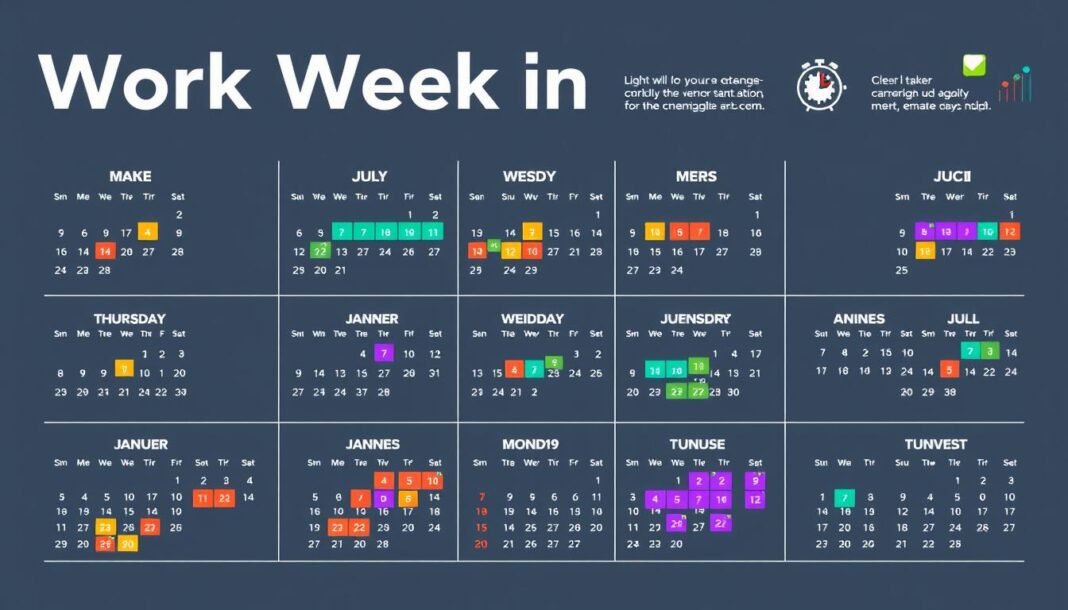This visually engaging calendar layout illustrates the concept of work weeks in a year. It features distinct sections for each month, highlighted workdays and weekends, colorful blocks representing the passing of time, and a modern design aesthetic with abstract elements symbolizing productivity and time management.
Work weeks in a year matter for U.S. employees and employers. The standard work year is 52 weeks.
Most Americans work 46-48 weeks yearly. This counts holidays, vacations, and sick days.
The yearly work calendar helps plan payroll and projects. Federal holidays and company time off affect work weeks.
Different jobs have unique workweek patterns. Tech firms, big companies, and small businesses manage schedules differently.
This guide explains work weeks in detail. You’ll learn how time off impacts your yearly work calendar.
Understanding the Standard Work Year
A standard work year in the U.S. typically lasts 52 weeks. Full-time employees usually work 40 hours weekly, totalling about 2,080 hours annually.
This benchmark applies to many industries. However, some sectors have unique scheduling needs that differ from traditional patterns.
Full-time jobs often include paid holidays and vacation days. Workers typically get 10-15 paid days off yearly.
The standard work year calculation accounts for these breaks. This helps employees balance work and personal life.
Government rules and company policies shape the standard work year. The Fair Labor Standards Act guides employers and workers on hours and pay.
Knowing your industry’s work year helps in career planning. It’s essential to check your job contract and company rules.
Calculating Work Weeks in a Year
Calculating the workweek is important for both employees and employers. A standard work year has 52 weeks, but actual work weeks can vary.
To find annual work hours, start with a 40-hour work week. Full-time equivalent (FTE) calculations begin with 52 weeks minus time off.
Most workers subtract vacation days, public holidays, and sick leave. After subtracting these days, a typical year has 47 work weeks.
Different industries and companies track annual work hours uniquely. Some use 260 days (52 weeks × 5 days) as their standard.
Check your employment contract for exact details about your annual work hours. Freelancers and contract workers often calculate work weeks differently.
They might track billable hours more precisely for project-based work. Understanding your employment structure is key to knowing your total annual working time.
Employers use FTE to plan their workforce and set pay strategies. This helps create fair metrics across different roles and work setups.
Factors Affecting Work Weeks
This is an abstract representation of work schedule flexibility, featuring a balanced scale weighing various factors like remote work, flexible hours, and teamwork. Surrounding the scale are diverse visual elements symbolizing personal life, productivity, communication tools, and time management, all interconnected with flowing lines and varying colors to convey dynamic interactions. The overall composition should evoke a sense of harmony and balance in the workplace.
Modern work environments have changed a lot. They now affect yearly work weeks in new ways.
Work schedule flexibility is essential for many workers and bosses. It’s a big deal in many jobs.
Part-time jobs help change old work patterns. Workers can now choose how much they want to work.
Some pick part-time work to handle personal tasks. Others do it to study more.
Seasonal work also changes yearly work weeks. Some jobs have busy and slow times.
Different jobs have different work schedules. Tech jobs often let you work when you want.
Factory and service jobs might have stricter schedules. This affects how many weeks people work each year.
Knowing these things helps workers plan better. They can make smart choices about their jobs.
The Impact of Remote Work
Digital work has changed how we do our jobs. It offers new ways to be flexible and productive.
Telecommuting gives workers more freedom. It allows people to focus on results, not strict schedules.
Companies are rethinking how they measure work. Remote workers often get more done without commuting.
Remote work connects people across time zones. This creates a more flexible work system.
Companies are changing how they manage remote teams. They’re adapting to this new way of working.
Working from home can blur work and personal life. People need to find ways to keep them separate.
This helps create a healthy remote work experience. It’s essential for long-term success.
Health and Wellbeing Considerations
Work-life balance is crucial for modern professionals. The number of work weeks affects employee mental health and job satisfaction.
Workplace wellness programs help fight employee burnout. Chronic stress can decrease productivity and cause health issues.
Organizations now see that supporting wellbeing is more than healthcare benefits. Innovative actions can build a stronger workforce.
Good work-life balance strategies include flexible schedules and clear personal time boundaries. Companies that focus on wellness often have happier, longer-lasting employees.
Experts suggest managing stress by using mindfulness, exercise, sleep, and support networks. Employers can create spaces that value employee wellbeing.
Tracking work weeks and wellness programs can reduce the effects of work stress. These efforts create healthier and more productive work environments.
Comparisons with Other Countries
Work cultures vary significantly around the world. The U.S. has a unique approach compared to other developed nations.
European countries often have better work-life balance policies. France and Germany challenge traditional American work standards.
Nordic countries lead in progressive labour practices. Sweden tests six-hour workdays for better productivity and employee wellbeing.
The Netherlands has one of the shortest work weeks globally. Many professionals there choose to work part-time.
Asian countries like Japan and South Korea had intense work cultures. Recent reforms aim to improve employee mental health.
Global workweek standards are changing. They reflect new attitudes toward productivity and life balance.
The U.S. keeps a traditional 40-hour work week. European and Nordic models offer different approaches.
These models focus on employee wellness and sustainable work practices.
Tips for Maximizing Productivity
Wise time management can transform how you work. Top pros know it’s about working smarter, not longer.
Strategic methods can boost your output and cut stress. Structured daily routines are key to being more productive.
Start by doing essential tasks when you’re most energetic. Use tools like Trello to track progress and cut time-wasters.
Break big projects into smaller parts. This helps keep you going and prevents feeling overwhelmed.
To work better, know your workflow. Try the Pomodoro method: 25 minutes of work, then a short break.
Cut distractions by setting clear limits on notifications. Create a unique workspace for better focus.
Exercise, sleep well, and eat right to perform at your best. Also, keep checking and improving your productivity methods.
Track progress and be ready to change your approach. Remember, getting better never stops.
Stay curious and open to growth. You’ll see your work skills improve.
FAQ
How many work weeks are there in a typical year?
A standard work year has 52 weeks. Full-time U.S. employees usually work 48-50 weeks.
Do part-time employees have the same number of work weeks?
Part-time employees have fewer work weeks. Their schedule depends on their specific job arrangement.
How do holidays affect the total number of work weeks?
Holidays reduce work weeks by 1-2 annually. Most companies offer 6-10 paid holidays yearly.
How does vacation time impact work weeks?
U.S. full-time workers get 2-3 weeks of paid vacation. This cuts work weeks to about 49-50 yearly.
Are work weeks calculated differently in remote work settings?
Remote work allows flexible scheduling. Yet, the 52-week calculation minus time off stays the same.
How do different industries affect workweek calculations?
Some jobs have unique schedules. Healthcare and shift-based jobs differ from 9-to-5 office work.
Can personal days or sick leave impact work weeks?
Yes, personal and sick days reduce active work weeks. Most full-time workers get several paid days off.
How do overtime and additional hours affect work weeks?
Overtime can extend work hours beyond 40 per week. This increases yearly hours without adding more weeks.
you may also read : Common Marketing Tactics Credit Card Companies Use to Market to Young Adults

